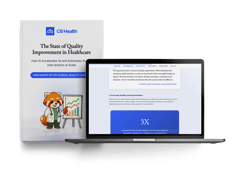
The Big List of Physician Burnout Statistics
The years since the COVID-19 pandemic have seen a sharp rise in physician burnout rates, leading to disaffected professionals fleeing the healthcare industry. While the situation comes as no surprise to those in the know, this comprehensive list of physician burnout statistics offers more insight into who is affected by burnout and what the implications are for the healthcare industry going forward.
High-Level Physician Burnout Statistics Since COVID-19
Burnout among physicians spiked during the pandemic and remains a crisis in 2025. Throughout the COVID-19 pandemic, doctors experienced unprecedented stress and workload, driving burnout rates to all-time highs. While recent data suggests slight improvements as the acute pandemic phase passes, burnout levels are still far above pre-pandemic norms. Below are key statistics illustrating how physician burnout has evolved through the pandemic era:
- Pandemic surge in burnout: During the Omicron wave in late 2021, 62.8% of U.S. physicians reported at least one symptom of burnout, the highest physician burnout rate ever recorded. Source: American Medical Association (AMA), 2022.
- By comparison, about 45% of all U.S. healthcare workers felt “burned out often or very often” in 2022, up from roughly one-third in 2018. Source: The Lancet, 2023.
- Even after the initial pandemic waves, physician burnout stayed high. In a major 2022 physician burnout survey, 53% of physicians reported feeling burned out, an increase of 11 percentage points from 2018. Source: Medical Society of the State of New York (MSSNY), 2022.
- By 2023 there was modest improvement – about 49% of physicians reported burnout in Medscape’s latest survey (down from 53%). Source: Medscape (via Augnito), 2024.
- This is still well above the ~44% burnout rate pre-COVID in 2019. In other words, nearly half of doctors remained burned out as of 2023, underscoring a persistent post-pandemic crisis. Source: Medscape (via Augnito), 2024.
|
|
“The fact that nearly half of our clinicians are still experiencing chronic burnout highlights the persistent stress burden across healthcare. This is a patient safety and operational integrity crisis.”
|
Reversing these trends requires a concentrated effort on the part of healthcare organizations and the individual teams that comprise them. Root causes like administrative overload and work-life balance can’t be overlooked.
Learn how C8 Health empowers hospitals to reduce cognitive overload and mitigate clinician burnout by delivering a seamless, workflow-integrated knowledge management platform. Trusted by 9 out of 10 users, C8 Health equips providers with the confidence to manage the accelerating pace of medical knowledge generation. The platform connects institutions to a nationwide knowledge network, allowing for the efficient creation and sharing of evidence-based protocols. With C8 Health, clinical teams gain one source of truth that supports high-quality, consistent care delivery. Explore the Platform.
Physician Burnout Rates by Specialty
|
Specialty |
Burnout Rate |
|
Emergency Medicine |
63-65% |
|
Internal Medicine |
60% |
|
Family Medicine |
50%-60% |
|
Pediatrics |
59% |
|
Obstetrics/Gynecology |
58% |
Physician burnout affects all medical specialties, but some are hit harder than others. Front-line and emergency responders tend to be the most affected by burnout symptoms.
- Emergency medicine consistently tops the list with about 63–65% of EM physicians reporting burnout, the highest of any specialty. Source: MSSNY, 2022.
- Other front-line fields follow close behind – for example, Internal Medicine (60% burnout) and Family Medicine ( 50% to 60%) are severely affected. Source: MSSNY, 2022.
- Pediatrics (59%) and Obstetrics/Gynecology (58%) were also among the specialties with the most burned-out doctors. Source: MSSNY, 2022.
- Every medical specialty saw significant burnout. At least one in three physicians in all specialties reported being burned out in 2022. Source: MSSNY, 2022.
- Even traditionally lower-stress specialties had substantial burnout prevalence. For instance, in 2023 surveys, Plastic Surgery had the lowest burnout rate at 37%, and others like Ophthalmology and Psychiatry hovered around 39%. Source: Healthgrades, 2024.
Burnout by specialty reflects how work demands and environment contribute to physician stress. Emergency and critical care physicians bore the brunt of COVID-19 surges, explaining their extreme burnout levels. Meanwhile, lower-burnout fields may have more control over schedules or fewer bureaucratic tasks, yet significant proportions are still struggling. These physician burnout statistics by specialty highlight the need for specialty-specific interventions. Specialty societies and hospital departments are starting to tailor wellness programs to address the unique pressures in each field.
Gender Disparities in Physician Burnout
Female physicians have long reported higher burnout rates than their male counterparts, and the pandemic exacerbated this gap. Women in medicine often juggle professional demands with disproportionate domestic responsibilities and face systemic issues like gender bias or pay gaps that contribute to burnout.
- Women report higher burnout than men: In 2020, 51% of U.S. women physicians reported feeling burned out, compared to 36% of male physicians. Source: Medscape (via PubMed), 2023.
- According to the same paper, this 15-point gender gap widened during the pandemic. By 2021, burnout had increased to 56% of women physicians versus 41% of men. Source: Medscape (via PubMed), 2023.
- Burnout manifests somewhat differently by gender. Women doctors report higher emotional exhaustion, whereas men report more depersonalization. Source: The Permanente Journal, 2023.
Addressing gender disparities in physician burnout is crucial for healthcare organizations. Solutions might include mentorship and leadership programs for women, more flexible scheduling or parental leave policies, and efforts to reduce implicit bias and harassment in the workplace. By understanding that physician mental health data show women at elevated risk, leadership can take targeted steps to support female providers and close the burnout gap.
Burnout Among Residents and Trainees
Burnout is strikingly high even at the earliest stages of a medical career. Resident physicians and medical trainees face grueling schedules, intense pressure to learn, and often a lack of control over their work environment, creating fertile ground for burnout.
- Approximately 60% of medical residents report frequent feelings of burnout, similar to their senior physician colleagues. Source: Physician’s Foundation, 2023.
- The same survey found that medical residents closely paralleled the burnout rate among attending physicians (also about 60%). Source: Physician’s Foundation, 2023.
- Burnout afflicts a large majority of medical students. About 7 in 10 medical students in 2023 reported frequently feeling burned out, a higher proportion than residents. Source: Physician’s Foundation, 2023.
- Certain training programs show especially high burnout. In a 2022 national survey of OB/GYN residents taking their in-training exam, 64.8% of residents screened positive for burnout symptoms. Source: PubMed, 2024.
- Similarly, past studies of internal medicine residents found burnout rates as high as 75% in some programs. Source: MDEdge, 2019.
This alarming trend among residents and trainees not only threatens the well-being of future clinicians but also signals deeper systemic issues in how medical knowledge and support are delivered. As these early-career professionals struggle under the weight of fragmented systems and overwhelming demands, it's clear that the industry needs structural reform.
To understand the broader implications of poor knowledge management in healthcare, download C8 Health’s latest report: The State of Knowledge Management in Hospitals
Impacts on Patient Care and Safety
Physician burnout is not just a workforce well-being issue – it directly endangers patient care quality and safety. Exhausted, disengaged doctors are more prone to mistakes, less empathetic in care, and may contribute to lower system performance. A growing body of research shows clear correlations between clinician burnout and negative patient outcomes. Healthcare leaders view this as a compelling reason to address burnout. It’s fundamentally a patient safety risk. Key data on how burnout impacts care include:
- Burned-out physicians are significantly more likely to make mistakes. Studies show that physicians experiencing burnout have roughly double the risk of being involved in a patient safety incident or error, compared to those without burnout. Source: PubMed, 2023.
- Another research paper noted that burned-out physicians were twice as likely to have lower patient safety and quality ratings for their clinical units. Source: Hodkinson A, Zhou A, Johnson J, et al., 2022.
- Researchers estimate that burnout may be a contributing factor in 7%–10% of all serious medical errors. Source: Tawfik DS, Profit J, Morgenthaler TI, et al, 2018.
- A Stanford Medicine study found that the “epidemic of physician burnout” could be responsible for more medical errors than even unsafe healthcare settings, which accounts for 100,000 to 200,000 deaths per year. Source: Stanford Medicine, 2018.
- Patients feel the effects when their physician is burned out. Studies link high clinician burnout to decreased patient satisfaction with care. Source: Healthcare Management Review, 2007.
|
|
“Burnout translates directly into patient risk. Clinicians under pressure are more likely to make mistakes, and patients notice the difference in care. Knowledge management is a huge part of this. More than 50% of surveyed healthcare workers in our State of Knowledge Management report stated they needed to extend their workdays due to inefficient knowledge systems”
|
Financial Consequences of High Physician Burnout Rate
Beyond the human and clinical toll, physician burnout carries a steep financial cost for healthcare systems. Burnout drives higher turnover, early retirements, reduced productivity, and even malpractice suits — all of which have economic implications. In an era of tight hospital margins and physician shortages, the financial consequences of physician burnout have leadership attention. Recent analyses have quantified just how expensive the burnout crisis is:
- A 2019 study estimated that physician burnout costs the U.S. healthcare system around $4.6 billion every year in aggregate. Source: BMC Health Services, 2018.
- Replacing a single physician is extremely costly. Estimates range from $268,000 up to $957,000 to recruit and train a new physician to fill a vacancy. Source: BMC Health Services, 2018.
- In one medical group management survey, 27% of healthcare organizations reported having a physician quit or retire early specifically due to burnout. Source: C8 Health.
- Today, more physicians are leaving the profession than entering it, partly because of burnout The result is a projected shortfall of 45,000 to 90,000 physicians in the coming years. Source: Mayo Clinic, 2017.
|
|
“High turnover, early retirements, and lost clinical productivity are financial bleeding points. Organizations must invest in structural solutions to stem the tide.”
|
While these problems are extreme, they aren’t insurmountable. With proper resources and emphasis on cultural change, hospitals can dramatically reduce their likelihood of staff developing extreme burnout symptoms.
Experience firsthand how C8 Health simplifies knowledge management and drives clinical excellence. In your personalized demo, we’ll show you how the platform seamlessly embeds into clinical workflows, automates resource updates and onboarding, and delivers real-time insights that support high adherence to best practices. C8 Health empowers your teams to work smarter — boosting provider satisfaction, reducing inefficiencies, and improving patient outcomes. See the impact for yourself. Book a demo today.
